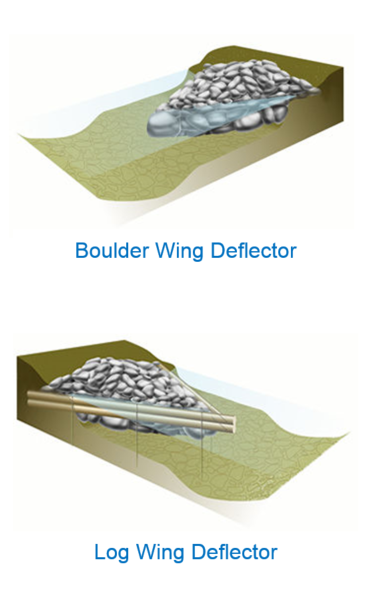Wing Deflectors
Adapted from Ontario’s Stream Rehabilitation Manual

Description
Wing deflectors are specifically designed as a solid triangular structure that reduces the width to depth ratio of the bankfull channel. Reducing channel width increases the stream velocity. The shape is important as it not only guides low flow, but also directs bankfull flows toward the thalweg (the line connecting the points of lowest bed elevation in a river channel), reducing stress on the banks. In terms of channel form, they are meant to behave as an artificial bar. Wing deflectors can be placed as single structures, in an alternating series or in opposing doubles. Common construction materials include river stone, logs or wood debris. They have a natural appearance and are easy to maintain if constructed in the appropriate channel type.
Effectiveness
In most circumstances, deflectors are simple to construct and a cost effective means of restoring a meandering thalweg to altered channels which are wide, shallow and sluggish.
Wing deflectors can enhance the formation of scour pools, guide current toward cover or direct flow away from an eroding bank. Individually, they can enhance the local meandering of the thalweg and concentrate flow toward natural or created bank cover.
In an alternating series, deflectors can create a deep meandering thalweg in a previously shallow and over widened channel. In opposing pairs, the deflectors further increase mid channel velocity and cause the formation of a scour pool. The scouring action maintains clean substrates which attract aquatic insects and spawning fish. Mid channel pools provide resting and feeding habitat which invite juvenile and adult fish.
Applicability
Wing deflectors are placed in shallow, over-widened reaches of stream which lack a well defined, meandering thalweg. The host channel should have a gentle slope and some form of past influence which has increased the width to depth ratio. This could be caused by dredging, unrestricted livestock access, channel straightening, under or over-sized culverts, or removal of riparian vegetation. As with all stream restoration work, it is important to identify and address the cause of the problem as well as the symptoms.
You will need a good understanding of the channel characteristics within the selected reach while having a similar awareness of a local reach which is in a stable form. Failing this comparison, one should have sufficient baseline information to predict stable channel geometry, such as information on the dynamic nature of seasonal flow, ice formation, debris movement and sediment transport. Sketches of the channel in plan view and cross section, indicating bankfull, low flow and thalweg are essential for determining suitability and positioning. Straight runs, glides and below the crest of riffles are suitable sites for locating wing deflectors. Wing deflectors are ideal in channels with a slope between 2 to 4% and with a predominant boulder, cobble or gravel lining. They may also work well in a variety of other channel types in combination with localized bank stabilization. This approach is not suited for streams with highly erodible substrates, high gradient or large volumes of ice and debris movement.
Deflectors should be designed to only alter the low flow and bankfull stages of the stream. Deflecting higher flows is generally discouraged due to the possibility of aggravated erosion and channel instability. It is imperative that you consult with an experienced river engineer for advice on suitability.
Design Considerations:
Wing deflectors are specifically designed in three dimensions as a tapered, triangular structure which points into the channel. Regardless of the materials used, there are common construction aspects that need to be addressed to maintain a functioning low profile presence in the bankfull channel:
- The position within the channel is very important. It determines channel velocity, the direction of current during low flow while also directing higher flows toward the center of the watercourse. The structure should not occupy more than one third of the width of the bankfull channel.
- The upstream angle of the deflector should range between 30 to 45 degrees from the bank to guide the flow toward the centre of the channel. The angle of the downstream log should be 90 degrees to the upstream edge (see illustration).
- The elevation of the tip of the deflector should not exceed two times the height of the low flow channel. The tip should also be in line with the centre of stable structure on the opposite bank. The arrangement should be gradually tapered back to the bank at the elevation of the bankfull stage. The final height should allow for ice and debris to flow over top during high flows.
- Stability under high flows is a very significant consideration which needs to be addressed through proper construction. Whether using rock or logs for the deflector, the structure should be sec2urely anchored into the bed and bank of the channel.
- 25 percent of the average height if the deflector should be excavated into the bed. Logs and rock should extend 1.2 to 2.5 meters into the bank.
Cost and Maintenance
Wing deflectors can be a low cost technique depending on the availability of materials, site access, channel size and need for heavy equipment. A crew of three experienced people can construct one small deflector in several hours. As channel size increases, so does the amount of materials and labor required to construct. These structures have varying degrees of longevity depending upon the materials used and the dynamic nature of the channel. Typically, they can last up to five years. Frequent monitoring and maintenance is recommended during the first year to ensure proper function, correct erosion problems or remove undesirable debris accumulation. Expected annual maintenance cost can range from $4.90 to $8.20 per foot (cost estimates adjusted to 2005 U.S. dollars) depending on the availability of rock. Continue with annual monitoring after the first year to ensure that the deflectors work properly.
References
Ontario’s Stream Rehabilitation Manual, Ontario Ministry of Natural Resources. 2000.